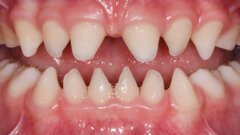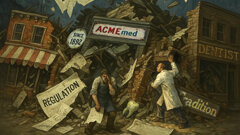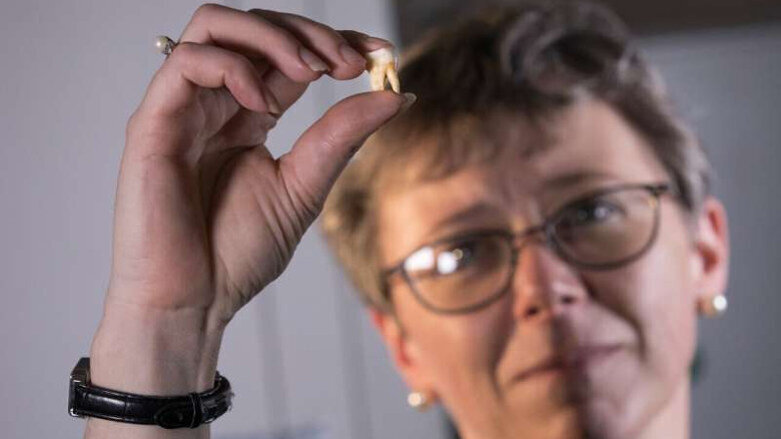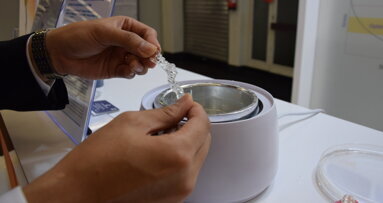HAMILTON, Canada: Teeth provide a permanent biological marker of metabolic stressors that disrupt mineralization in utero and in early childhood. A recent study by researchers from McMaster University in Hamilton set out to evaluate whether mineralization defects in dentin could be caused by vitamin D deficiency in the critical first 1,000 days of life. They have found that a person’s first permanent molars carry a lifelong record of health information dating back to the prenatal phase, storing vital information that can connect maternal health to a child’s health.
Dentin forms in microscopic layers and its adequate formation depends on the presence of vitamin D. Dark streaks develop in the dentin during those periods in which the body is deprived of the nutrient, usually owing to a lack of sunlight. Prior to this study, the research team had established that such microscopic defects remain in place and can be read later. Because teeth do not decay as rapidly as body tissue and bone, they can retain such information for hundreds of years postmortem.
Prof. Megan Brickley, Canada Research Chair in Bioarchaeology of Human Disease in the Department of Anthropology at the university, explained that, combined with other data, patterns in dentin can create rich banks of knowledge about past conditions, including information about the health impacts of living in low-light environments. “It’s a living fossil of your life, starting in utero,” said Brickley. “Conceivably, it would be possible to remove the molar of anyone and compare their health to the evidence in the tooth.”
Such records begin during the original formation of teeth in the fetal stage, and now the research team has established their value for reflecting the health of the mother during pregnancy. The first permanent molars start forming in utero and retain a record of vitamin D intake dating back to the mother’s pregnancy. That record provides a critical intergenerational link that can offer valuable clues connecting maternal health to the eventual health of a child.
“We’ve been able to set out really clear evidence that there is part of the first permanent molar that records what happened in the life of the mother,” said Brickley. “This is a tool that people can use. It can be used in current health research, and in bioarcheological research.”
The researchers examined modern and archeological tooth samples, including teeth taken from two skeletons from 19th century Quebec—one from a 3-year-old girl who had survived rickets as a toddler, and one from a young man. The girl’s undescended molar showed that her mother had suffered a vitamin D deficiency during pregnancy—a possible clue to the child’s early death. The young man’s molar also showed that his mother had suffered vitamin D deficiency, indicating the possibility of a connection between his mother’s health and his early death.
During that time, Brickley explained, social practices and weather conditions meant that pregnant women, in particular, would have had very little exposure to the sun. It only later became clear how necessary sunlight or substitute sources of vitamin D are to good health.
The study, titled “Using teeth as tools: Investigating the mother–infant dyad and developmental origins of health and disease hypothesis using vitamin D deficiency,” was published online on Nov. 11, 2019, in the American Journal of Physical Anthropology, ahead of inclusion in an issue.
Tags:
SEOUL, South Korea: Identifying risk factors for preterm birth (PTB) is crucial for enabling healthcare providers, parents and policymakers to make informed...
KRIENS, Switzerland: With an estimated 743 million people affected, periodontitis is a major global health burden. The condition is usually initiated by ...
A 75-year-old female patient visited our dental clinic reporting a loose crown on tooth #26. The tooth had been endodontically treated in the past and had a...
Oral surgery is an important cornerstone in orthodontic treatment of malocclusions. Tooth movement is only possible to a limited extent and always depends ...
SYDNEY, Australia: When it comes to the development of children’s habits, the influence their teachers hold in this regard is clear. In a new review study...
Dr Dympna Kavanagh is chief dental officer in Ireland’s Department of Health and chair of the Platform for Better Oral Health in Europe. A specialist in ...
ANN ARBOR, Mich., U.S.: As soon as the first tooth appears, parents should start taking their child to the dentist for regular checkups. What seems like a ...
SYDNEY, Australia: For some women, hormonal changes that occur owing to pregnancy can lead to oral health problems such as dental caries and periodontal ...
SYDNEY, Australia: Most often, the images associated with the word dentistry are a chair in a room, bright lights and two or three sets of eyes peering into...
COLOGNE, Germany: At the 39th International Dental Show (IDS) in September, South Korean manufacturer Graphy showcased the world’s first direct 3D-printed...
Live webinar
Wed. 14 January 2026
12:00 pm EST (New York)
Dr. Théo Laplane, Dr. Robert Gottlander DDS
Live webinar
Fri. 16 January 2026
12:00 pm EST (New York)
Live webinar
Mon. 19 January 2026
1:00 pm EST (New York)
Philipp Kopp, Michael Seeber
Live webinar
Thu. 22 January 2026
9:00 am EST (New York)
Prof. Judith Jones D.D.S; M.P.H., Prof. Kakuhiro Fukai D.D.S., Ph.D, Dr. Bathsheba (Bethy) Turton
Live webinar
Thu. 22 January 2026
2:00 pm EST (New York)
Dr. Nicola M. Grande DDS, PhD
Live webinar
Wed. 28 January 2026
8:00 am EST (New York)
Live webinar
Wed. 28 January 2026
11:00 am EST (New York)
Prof. Dr. Jan-Frederik Güth



 Austria / Österreich
Austria / Österreich
 Bosnia and Herzegovina / Босна и Херцеговина
Bosnia and Herzegovina / Босна и Херцеговина
 Bulgaria / България
Bulgaria / България
 Croatia / Hrvatska
Croatia / Hrvatska
 Czech Republic & Slovakia / Česká republika & Slovensko
Czech Republic & Slovakia / Česká republika & Slovensko
 France / France
France / France
 Germany / Deutschland
Germany / Deutschland
 Greece / ΕΛΛΑΔΑ
Greece / ΕΛΛΑΔΑ
 Hungary / Hungary
Hungary / Hungary
 Italy / Italia
Italy / Italia
 Netherlands / Nederland
Netherlands / Nederland
 Nordic / Nordic
Nordic / Nordic
 Poland / Polska
Poland / Polska
 Portugal / Portugal
Portugal / Portugal
 Romania & Moldova / România & Moldova
Romania & Moldova / România & Moldova
 Slovenia / Slovenija
Slovenia / Slovenija
 Serbia & Montenegro / Србија и Црна Гора
Serbia & Montenegro / Србија и Црна Гора
 Spain / España
Spain / España
 Switzerland / Schweiz
Switzerland / Schweiz
 Turkey / Türkiye
Turkey / Türkiye
 UK & Ireland / UK & Ireland
UK & Ireland / UK & Ireland
 Brazil / Brasil
Brazil / Brasil
 Canada / Canada
Canada / Canada
 Latin America / Latinoamérica
Latin America / Latinoamérica
 USA / USA
USA / USA
 China / 中国
China / 中国
 India / भारत गणराज्य
India / भारत गणराज्य
 Pakistan / Pākistān
Pakistan / Pākistān
 Vietnam / Việt Nam
Vietnam / Việt Nam
 ASEAN / ASEAN
ASEAN / ASEAN
 Israel / מְדִינַת יִשְׂרָאֵל
Israel / מְדִינַת יִשְׂרָאֵל
 Algeria, Morocco & Tunisia / الجزائر والمغرب وتونس
Algeria, Morocco & Tunisia / الجزائر والمغرب وتونس
 Middle East / Middle East
Middle East / Middle East
















































To post a reply please login or register